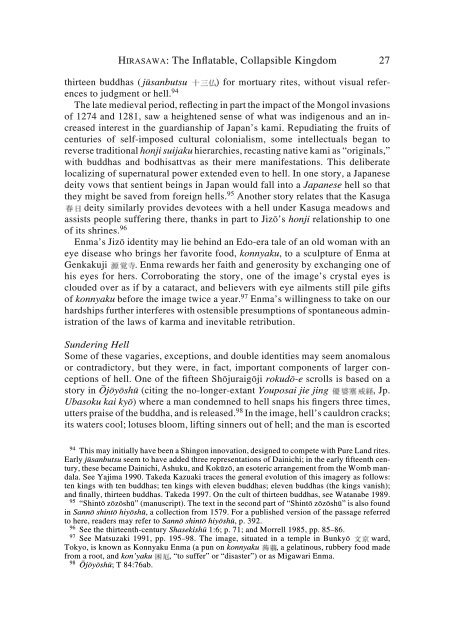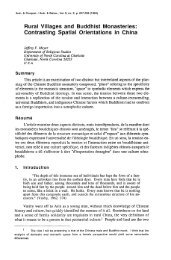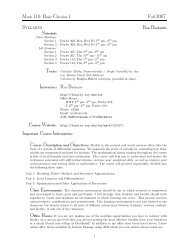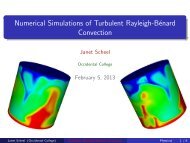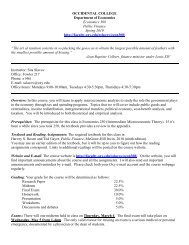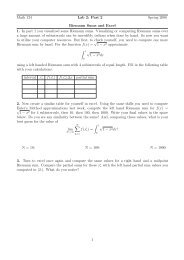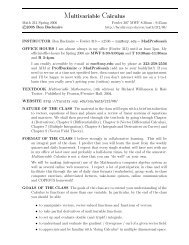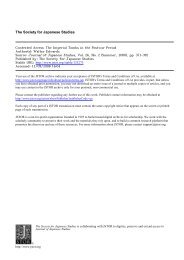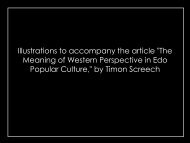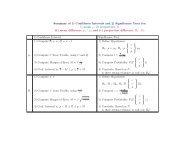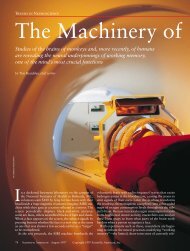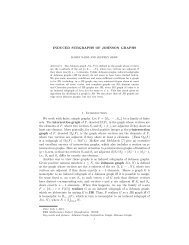A Primer on Japanese Hell Imagery and Imagination - Occidental ...
A Primer on Japanese Hell Imagery and Imagination - Occidental ...
A Primer on Japanese Hell Imagery and Imagination - Occidental ...
Create successful ePaper yourself
Turn your PDF publications into a flip-book with our unique Google optimized e-Paper software.
HIRASAWA: The Inflatable, Collapsible Kingdom 27<br />
thirteen buddhas ( jûsanbutsu ) for mortuary rites, without visual references<br />
to judgment or hell. 94<br />
The late medieval period, reflecting in part the impact of the M<strong>on</strong>gol invasi<strong>on</strong>s<br />
of 1274 <strong>and</strong> 1281, saw a heightened sense of what was indigenous <strong>and</strong> an increased<br />
interest in the guardianship of Japan’s kami. Repudiating the fruits of<br />
centuries of self-imposed cultural col<strong>on</strong>ialism, some intellectuals began to<br />
reverse traditi<strong>on</strong>al h<strong>on</strong>ji suijaku hierarchies, recasting native kami as “originals,”<br />
with buddhas <strong>and</strong> bodhisattvas as their mere manifestati<strong>on</strong>s. This deliberate<br />
localizing of supernatural power extended even to hell. In <strong>on</strong>e story, a <strong>Japanese</strong><br />
deity vows that sentient beings in Japan would fall into a <strong>Japanese</strong> hell so that<br />
they might be saved from foreign hells. 95 Another story relates that the Kasuga<br />
deity similarly provides devotees with a hell under Kasuga meadows <strong>and</strong><br />
assists people suffering there, thanks in part to Jizô’s h<strong>on</strong>ji relati<strong>on</strong>ship to <strong>on</strong>e<br />
of its shrines. 96<br />
Enma’s Jizô identity may lie behind an Edo-era tale of an old woman with an<br />
eye disease who brings her favorite food, k<strong>on</strong>nyaku, to a sculpture of Enma at<br />
Genkakuji . Enma rewards her faith <strong>and</strong> generosity by exchanging <strong>on</strong>e of<br />
his eyes for hers. Corroborating the story, <strong>on</strong>e of the image’s crystal eyes is<br />
clouded over as if by a cataract, <strong>and</strong> believers with eye ailments still pile gifts<br />
of k<strong>on</strong>nyaku before the image twice a year. 97 Enma’s willingness to take <strong>on</strong> our<br />
hardships further interferes with ostensible presumpti<strong>on</strong>s of sp<strong>on</strong>taneous administrati<strong>on</strong><br />
of the laws of karma <strong>and</strong> inevitable retributi<strong>on</strong>.<br />
Sundering <strong>Hell</strong><br />
Some of these vagaries, excepti<strong>on</strong>s, <strong>and</strong> double identities may seem anomalous<br />
or c<strong>on</strong>tradictory, but they were, in fact, important comp<strong>on</strong>ents of larger c<strong>on</strong>cepti<strong>on</strong>s<br />
of hell. One of the fifteen Shôjuraigôji rokudô-e scrolls is based <strong>on</strong> a<br />
story in Ôjôyôshû (citing the no-l<strong>on</strong>ger-extant Youposai jie jing , Jp.<br />
Ubasoku kai kyô) where a man c<strong>on</strong>demned to hell snaps his fingers three times,<br />
utters praise of the buddha, <strong>and</strong> is released. 98 In the image, hell’s cauldr<strong>on</strong> cracks;<br />
its waters cool; lotuses bloom, lifting sinners out of hell; <strong>and</strong> the man is escorted<br />
94 This may initially have been a Shing<strong>on</strong> innovati<strong>on</strong>, designed to compete with Pure L<strong>and</strong> rites.<br />
Early jûsanbutsu seem to have added three representati<strong>on</strong>s of Dainichi; in the early fifteenth century,<br />
these became Dainichi, Ashuku, <strong>and</strong> Kokûzô, an esoteric arrangement from the Womb m<strong>and</strong>ala.<br />
See Yajima 1990. Takeda Kazuaki traces the general evoluti<strong>on</strong> of this imagery as follows:<br />
ten kings with ten buddhas; ten kings with eleven buddhas; eleven buddhas (the kings vanish);<br />
<strong>and</strong> finally, thirteen buddhas. Takeda 1997. On the cult of thirteen buddhas, see Watanabe 1989.<br />
95 “Shintô zôzôshû” (manuscript). The text in the sec<strong>on</strong>d part of “Shintô zôzôshû” is also found<br />
in Sannô shintô hiyôshû, a collecti<strong>on</strong> from 1579. For a published versi<strong>on</strong> of the passage referred<br />
to here, readers may refer to Sannô shintô hiyôshû, p. 392.<br />
96 See the thirteenth-century Shasekishû 1:6; p. 71; <strong>and</strong> Morrell 1985, pp. 85–86.<br />
97 See Matsuzaki 1991, pp. 195–98. The image, situated in a temple in Bunkyô ward,<br />
Tokyo, is known as K<strong>on</strong>nyaku Enma (a pun <strong>on</strong> k<strong>on</strong>nyaku , a gelatinous, rubbery food made<br />
from a root, <strong>and</strong> k<strong>on</strong>’yaku , “to suffer” or “disaster”) or as Migawari Enma.<br />
98 Ôjôyôshû; T 84:76ab.


